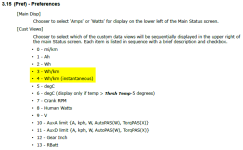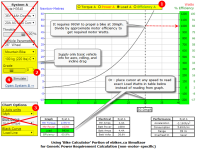Hi
I know that the Cycle Analist has a Wh/Mi in it that after about half a mile it gives the average Wh/Mi since the last reset, what I am looking for is a formula for working it out on the fly so to speak.
The measurements I have avalible to me is M/h, W ,A, V , distance in miles and W/h. I have an idea of a formula but am not sure, of the things I can measure I discount V and A as combined they give I am leaning towards Watts and speed, to do an example calculation I will consider the values to be constant speed =20M/hr power 1000W, from that we can derive that in 1 hour 1000 W/h will be used and 20 miles will be traveled, so in 1 mile 1000/20 W/h will be used which is 50W/h per mile or 50 W/m. This example is not very efficient but it is only an example.
From that calculation it can be derived that the W/m being traveled at any one moment is the Watts drawn decided by the speed.
Constantly working this out on the fly would be dangerous so I would work out common values to for example speed 10mph you just decide the Watts by 10.
Are my calculations correct or have I messed up some how?
Geoff
I know that the Cycle Analist has a Wh/Mi in it that after about half a mile it gives the average Wh/Mi since the last reset, what I am looking for is a formula for working it out on the fly so to speak.
The measurements I have avalible to me is M/h, W ,A, V , distance in miles and W/h. I have an idea of a formula but am not sure, of the things I can measure I discount V and A as combined they give I am leaning towards Watts and speed, to do an example calculation I will consider the values to be constant speed =20M/hr power 1000W, from that we can derive that in 1 hour 1000 W/h will be used and 20 miles will be traveled, so in 1 mile 1000/20 W/h will be used which is 50W/h per mile or 50 W/m. This example is not very efficient but it is only an example.
From that calculation it can be derived that the W/m being traveled at any one moment is the Watts drawn decided by the speed.
Constantly working this out on the fly would be dangerous so I would work out common values to for example speed 10mph you just decide the Watts by 10.
Are my calculations correct or have I messed up some how?
Geoff



